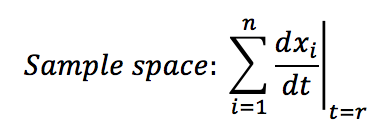Team:Colombia/Modeling/Stochastic
From 2012.igem.org
Template:Https://2012.igem.org/User:Tabima
Stochastic Model
The previous sections showed how to know the mean behavior of the system for one cell, but this is just an average of the total proteins within the cell. All the biological systems are controlled by probability events. The cell is a huge space where there are a lot of small molecules. If we want a biological process to happen, two of these molecules have to find each other among millions in a huge pool. The differential equations do not take into account these uncontrollable events that can change the response dramatically.
If we look only at one cell, it may not behave like we want and the system may not respond. Even worse, the probability of dying exist and our cell may die. But dealing with one cell is not real and we always work with hundreds of cells. Within this population, some cells may not behave as expected but others will and the average of cells would be able to respond to the presence of the pest.
The stochastic algorithms are a way to model these probability events within a population. This simulation is made in order to confirm that the system dynamics are robust, consistent and show us if the response is still behaving like we want (taking probabilities into consideration). We use the Gillespie algorithm to develop our model. Here is a brief explanation of how it works:
The complete method consists of eight steps.
- Define the number of cells.
- Define the number of steps
- Define and name all the constants involved.
- Define creation and destruction events for each substance involved: The differential equations in this part have to be divided in two, the creation and the destruction expression.
- Apply [http://www.annualreviews.org/doi/pdf/10.1146/annurev.physchem.58.032806.104637 Gilliespie algorithm:]
- • Calculate the sample space of the analyzed system: This is the sum of all the changes presented at specific time "t".
- •Calculate time distribution that depends on a random number between 0 and 1.
- •Calculate which event occurs: The Gillespie algorithm does not consider simultaneous events, this is that in each time only one event occurs. In this case, the events are the creation or destruction of one protein. Each event has a probability of occurrence within the sample space between 0 and 1. To know which event occurs at the time "t+1", we take into account the random number use for the time distribution and look for the event that has this probability of occurrence . For example, if you see the sample space figure below, there are 5 possible events with their probability; if the random number is 0.4 then A is going to be destructed but if the random number is 0.55. then B will be created.
- 6. Take the outputs from the simulation and convert them into regular interval vectors.
- 7. Obtain the Gillespie function mean values.
- 8. Plot the obtained functions.
 "
"


